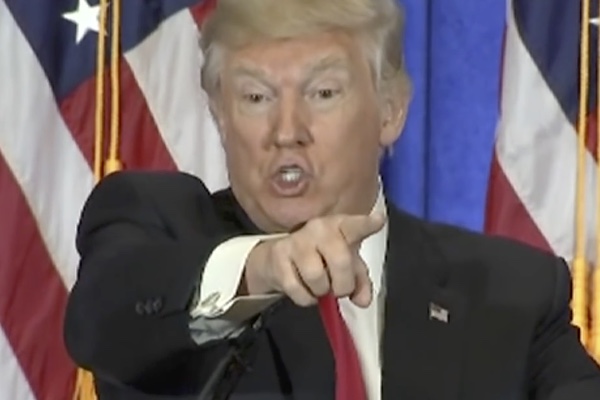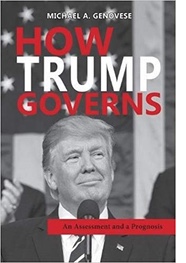What’s Wrong with Donald Trump’s Chaos Theory of Power?

Related Link Nixon, Trump and the Strange Career of the Madman Theory By Jeff Kimball
Am I the only one who thinks there is method in Donald Trump’s madness? Madness it certainly is, on several levels, but in some instances it is purposeful madness.
 This madness takes form in President Trump’s approach to governing, what can be called “the Chaos Theory of Governing.” Coming from a background of business where disruptive forces (e.g. new technologies) can have a profound effect on the way business is conducted, Trump has adopted a business model to the business of governing. President Trump’s chaos theory allows him to play a different, unorthodox game, and as he is the President, others must respond to and play Trump’s game. Just what do we mean by “chaos theory”?
This madness takes form in President Trump’s approach to governing, what can be called “the Chaos Theory of Governing.” Coming from a background of business where disruptive forces (e.g. new technologies) can have a profound effect on the way business is conducted, Trump has adopted a business model to the business of governing. President Trump’s chaos theory allows him to play a different, unorthodox game, and as he is the President, others must respond to and play Trump’s game. Just what do we mean by “chaos theory”?
It is often said that chaos is “the science of surprises.” These surprises are non-linear and therefore, unpredictable. Surprises…surprise us; they throw us off. We like the expected, the predictable that to which we are accustomed, the sure thing. Chaos theory would have us “expect the unexpected.” We don’t like that. Ambiguity causes stress. It defies reason. But all is not lost. Perhaps we can achieve some “deterministic chaos.”
Science is grounded in the predictable…gravity, one plus one equals two, up is up. But chaos upends certainty. Weather, clouds, the stock market, are impossible to predict with precision, they are complex, interrelated, and changing. Does that mean all is hopeless? No, we can still predict, even understand, develop new insights into the nature of things. And while absolute certainty eludes us, in seeing the connections between say, ecosystems, social systems, and human behavior, and how they interrelate, we might be able to offset catastrophes and develop sound policies for dealing with unfolding perils.
These systems may appear to be chaotic, but there is method to this seeming madness. Random or chaotic behaviors can be defined by mathematical formulae and are thus not as chaotic as they may appear.
In nature as in managing a complex organization, chaos may be used to pursue desired outcomes. Individuals as well as organizations must learn to live with uncertainty and change, and the more adaptable, the greater the chances of success.
Chaos theory is useful in examining various forms of leadership, political and otherwise. In this formulation, a leader impacts the behavior of others, quite often in random or unpredictable ways. The when and how of leadership may be a function of the would-be leader making a choice to introduce something new, behave in a different manner than expected, break from the confines of expected norms or create new coalitions and patterns. Others, then, must respond to the leader’s input. The goal is to always keep ‘em guessing, keep ‘em off balance, shake things up. This gives the leader the advantage.
Enter Donald J. Trump, the master of applying chaos theory to presidential leadership. Trump is unconventional by temperament and by design. Expect the unexpected. The unusual becomes the usual. If he is busting norms he is also busting expectations, and throwing adversaries off balance and contemptuous of process. And his adversaries often react dysfunctionally to Trump’s provocative actions.
Donald Trump’s chaos theory was evident in a number of his business ventures. His efforts to build a casino in Atlantic City, New Jersey is but one of numerous examples of Trump playing one lender off against another, one potential partner off against another, and one investor off against another. In a world where chaos reigned, where the left hand of investors did not know what the right hand of the banks knew, only Trump saw the big picture, and only Trump could play one off against the other. In the end, Trump was able to build his casino only because he was able to juggle several balls in the air at once, and keep one ball from knowing what the others were doing. Thus, chaos led to Trump pulling most of the strings.
Trump is a wrecking ball who can tear down, but leadership also involves building up. He can tear down Obamacare, take a sledge hammer to our immigration policy, trash NATO and the Atlantic Alliance, or threaten to withdraw from NAFTA, but when they are reduced to rubble, what is left? He can repeal, but has not been able to replace. This is one of the obvious limitations on applying chaos theory to governing. Government by temper tantrum has a short shelf life. Throwing a hand grenade into a room can certainly disrupt the norm, force others to scramble, but what is left after the grenade explodes?
Take North Korea. Trump’s inflammatory rhetoric and incendiary threats seemed to force the hand of Kim Jong Un. But after the shakeup, and after the historic summit meeting, North Korea seemed not to have made any real concessions, and nothing of real substance emerged from this. It was big on optics but not results. Chaos, but no resolution.
Donald Trump’s acknowledged model from past presidents is Andrew Jackson, another outsider who served as a disruptive force in national politics. Jackson once said that “I was born for the storm, and a calm does not suit me.” So too with Trump. He tries to reshuffle the deck so as to gain the advantage. But can he actually govern this way?
His “nanny cabinet” of minders may try to keep the spoiled child in Trump contained, but in the end, he is the boss and can do as he chooses. And inflicting chaos gives this president a sense of being in command, wielding power, being strong.
A word of caution: decision making involves a complex web of factors, and no single theory encompasses every aspect of this process. No individual can be reduced down to one, narrow element. No simple formula applies to all. President Trump also exhibits a range of other attributes that go into the process of decision making. He is a narcissist, relies on lessons from his past, rarely reads and knows little of history, and he exhibits misogynistic personality traits. All these factors, and more, go into the decisions the president makes.
Additionally, no president is an island. A vast institution surrounds and sometimes hems in a president. Advisers and cabinet officials, often attempt to temper Trump’s instincts with evidence and arguments designed to control the grosser manifestations of the Trump psyche. But try as they might, this nanny cabinet cannot always house train the alpha dog in the White House, or conversely, coax the president referred to as “Putin’s poodle” to be less of a lap dog to our adversary.
Is a chaos theory of governing suitable to leading a system of separation of powers and checks and balances? It does throw political opponents off kilter, but it also confuses and dismays our allies as well. Plus, you can’t actually lead when all you are doing is disrupting. Leadership requires cooperation, and it is hard to get others to follow you when the would-be leader sends out confusing and conflicting messages. Donald Trump tears down but he does not build up. That is demolition, not leadership.